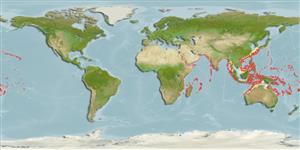>
Eupercaria/misc (Various families in series Eupercaria) >
Lutjanidae (Snappers) > Etelinae
Etymology: Etelis: Greek, etelis, -idos = a fish, perhaps the fish Sparus aurata (Ref. 45335).
More on author: Cuvier.
Environment: milieu / climate zone / distribuzione batimetrica / distribution range
Ecologia
marino benthopelagico; distribuzione batimetrica 90 - 400 m (Ref. 9821), usually 200 - 350 m (Ref. 82366). Tropical; 34°N - 25°S, 35°E - 150°W (Ref. 55)
Indo-Pacific: East Africa to the Hawaiian Islands, north to southern Japan, south to Australia. Recorded in Three Kings Island, New Zealand (Ref. 35942). This name has been wrongly used for Etelis coruscans by some previous authors.
Length at first maturity / Size / Peso / Age
Maturità: Lm 61.0 range ? - ? cm
Max length : 127 cm FL maschio/sesso non determinato; (Ref. 2016); common length : 65.0 cm TL maschio/sesso non determinato; (Ref. 5450); Età massima riportata: 32 anni (Ref. 92312)
Spine dorsali (totale) : 10; Raggi dorsali molli (totale) : 11; Spine anali: 3; Raggi anali molli: 8. This species is distinguished by having the following characters: body relatively elongate, laterally compressed. Nostrils on each side of snout close together; lower jaw protruding slightly; premaxillae protrusible and maxilla extending to below middle of eye; both upper and lower jaws with conical teeth; 1 to several enlarged canines on each side of both jaws; vomer and palatines with teeth, those on vomer in a chevron-shaped patch; maxilla with scales,
but without longitudinal ridges. Interorbital region flattened; gill rakers of first gill arch 5-8 + 11-14 = 17-22 (including rudiments; dorsal fin continuous, but spinous portion of fin deeply incised at its junction with soft portion; last soft ray of both dorsal and anal fins produced, longer than next to last ray; caudal fin forked, the lobes relatively short (about 25-30% SL) compared with its congeners; pectoral fins fairly long (in specimens > 19 cm SL), length of pectoral fins about 80-90% of head length, with 15-17 rays; membranes of dorsal and anal fins without scales; tubed lateral-line scales 48-50. Colour: mainly pink to red, becoming white on lower sides and belly (Rfe. 9821).
Body shape (shape guide): fusiform / normal; Cross section: oval.
Adults inhabit rocky bottoms (Ref. 30573). Benthopelagic (Ref. 58302). Feed on fishes and larger invertebrates such as squids, shrimps and crabs; also takes planktonic organisms, including pelagic urochordates. An important food fish in some areas. Marketed fresh or frozen (Ref. 55).
Life cycle and mating behavior
Maturità | Riproduzione | Deposizione | Uova | Fecundity | Larve
Allen, G.R., 1985. FAO Species Catalogue. Vol. 6. Snappers of the world. An annotated and illustrated catalogue of lutjanid species known to date. FAO Fish. Synop. 125(6):208 p. Rome: FAO. (Ref. 55)
IUCN Red List Status (Ref. 130435: Version 2025-1)
Threat to humans
Harmless
Human uses
Pesca: elevato interesse commerciale; Pesce da pesca sportiva: si
Strumenti
Special reports
Download XML
Fonti Internet
Estimates based on models
Preferred temperature (Fonte Biblio.
123201): 13.3 - 23.1, mean 18 °C (based on 290 cells).
Phylogenetic diversity index (Fonte Biblio.
82804): PD
50 = 0.5312 [Uniqueness, from 0.5 = low to 2.0 = high].
Bayesian length-weight: a=0.01585 (0.01278 - 0.01966), b=2.95 (2.89 - 3.01), in cm total length, based on LWR estimates for this species (Ref.
93245).
Trophic level (Fonte Biblio.
69278): 4.5 ±0.8 se; based on diet studies.
Resilienza (Fonte Biblio.
120179): Molto basso, tempo minimo di raddoppiamento della popolazione più di 14 anni (K=0.07-0.31; tmax=35).
Fishing Vulnerability (Ref.
59153): High to very high vulnerability (67 of 100).
🛈
Nutrients (Ref.
124155): Calcium = 44.5 [17.0, 103.8] mg/100g; Iron = 0.766 [0.383, 1.419] mg/100g; Protein = 18 [16, 20] %; Omega3 = 0.252 [0.142, 0.453] g/100g; Selenium = 106 [54, 230] μg/100g; VitaminA = 24.6 [7.7, 86.8] μg/100g; Zinc = 0.629 [0.408, 0.953] mg/100g (wet weight);
